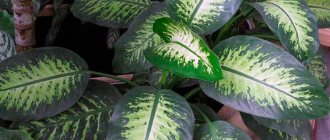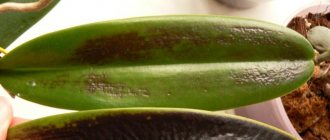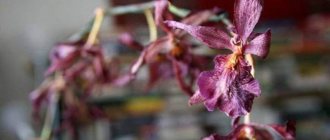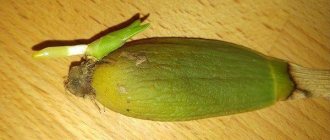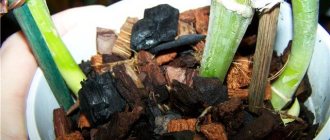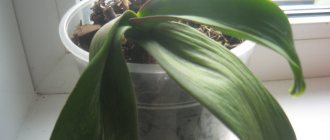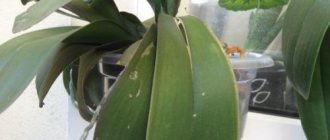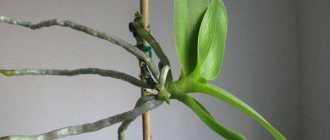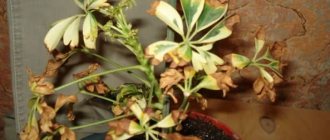3
(3)
Among novice orchid lovers, there is an opinion that growing orchids is difficult. This is wrong! Coping with beautiful plants is not so difficult if you know the features of their structure and care. One of the important nuances is watering. Orchid leaves do not tolerate excess moisture, especially stagnant water in the sinuses. For this reason, they are rarely irrigated using the traditional sprinkler method. To avoid damage to the leaves, it is better to wipe them. This method of care applies not only to watering, but also to fertilizing and protecting plants from diseases and pests. Leaf plates will look more impressive if a special material is applied to them for shine.
In our article, we will tell you how to wipe the leaves and what products to use.
Why wipe leaves with polish?
The polish will cover the surface with a protective film and give the leaves shine and beauty . Its use does not exclude orchid care, which is always visible from the condition of the leaves.
The leaf skin is a special covering tissue that protects the internal tissues from :
- Drying;
- Various damages;
- Invasion of microorganisms.
Orchid polish is often used to wipe the leaves.
Despite the fact that after treating leaves with wax or oil polishes, a film forms on the surface of the leaf blade, the composition of commercial polishes is selected so as not to disrupt gas exchange in the leaf cells .
Important! By following the instructions, you will not harm the plant.
Terms of use
When using industrial polishes and homemade polishing compounds, there are precautions :
- Application is possible only for flowers that grow in diffused light or partial shade, as under the influence of direct sunlight the leaves can get a chemical burn;
- Before processing, contamination must be removed from the leaves;
- Only hard and leathery leaves, without lint and fluffiness, are treated with polishes;
- Rub only the outer part of the sheet. The reverse side of the leaf, stem and shoots are not wiped, as they must breathe;
- Do not apply polish to young, growing leaves, as this can lead to their death.
Since the plant may react negatively to the polishing agent, its effect is first tested on several leaves. The flower observation time for industrial polishes is two to three days, for home compositions – one week.
Application technology
Before applying the polishing agent, clean the leaves from dust using a damp cloth or sponge:
- Cleaning is carried out in the morning or afternoon so that the leaves are completely dry before evening;
- The sheet is cleaned both from the top and back sides;
- If the foliage is washed in the shower, then the substrate should be carefully covered with plastic wrap;
- In case of significant contamination, it is allowed to use foam from mild soap or shampoos, then rinse it thoroughly with clean water.
If after this the shine of the orchid leaves is not enough for you, then the next day you can apply polishing agents .
Removing dust and dirt
An orchid becomes dirty especially quickly if it is standing near an open window or on a balcony. Of course, the location of the house matters. The easiest and most affordable way is to wipe the leaves with plain water.
The water should be at room temperature or slightly warm.
Procedure:
- Soak a cotton pad or piece of soft cloth in water and squeeze lightly.
- Wipe the leaves from the outside and inside.
As the cotton pad gets dirty, you can change it, and the fabric should be thoroughly rinsed periodically.
It is necessary to constantly monitor so that droplets of water do not fall into hard-to-reach leaf sinuses. Regular stagnation of moisture can cause rotting of the orchid neck
Sometimes watering phalaenopsis can be done by showering. Thanks to such manipulations, all leaf dust will be washed away and pores clogged with dirt will open.
Before the procedure, it is necessary to reliably protect the substrate by covering the pot with a plastic bag or wrapping it with film. Rinsing is carried out under low pressure using a fine nozzle.
After such a shower, it is necessary to remove excess water from the sinuses and return the orchid to its original place.
Homemade ways to care for leaves
Long before the discovery of plant polishes, which are popular in our time, good housewives knew how to wipe the leaves of indoor flowers until they shine.
At home, you must remember to care for orchid leaves.
To do this, they used inexpensive natural ingredients and prepared the compositions themselves.
Advantages and disadvantages
The advantages of home polishes include :
- Ease of preparation;
- Natural ingredients;
- Shine of leaves after application of preparations.
But the disadvantages of home remedies, compared to industrial polishes, are much greater, as are the risks for plants. Home remedies are characterized by :
- Low efficiency;
- Unforeseen effects on the plant;
- Polishing leaves with homemade compounds takes a lot of time;
- The selection of ingredient ratios is a constant experimentation.
Carefully! If home remedies are not washed off, applied too often or in excess quantities, they will create an environment favorable for the proliferation of microorganisms and pests.
polish the leaves no more than once a month.
Norms for the use of funds
Recipes for homemade leaf polishes have been known for a long time and have a large number of admirers:
- Sugar syrup and honey. The leaves are wiped with sweetened boiled water of the following composition: four teaspoons of sugar or two teaspoons of honey, dissolved in 200 g of water;
- Lemon acid. After spraying with hard water, a limescale deposit appears on the leaves - the result of a large amount of salts in the water. It can be easily removed using a citric acid solution:
- 1/3 tsp. citric acid is diluted in one liter of water;
Instead of citric acid, you can dilute freshly squeezed pineapple or sour apple juice.
A solution made from natural products is not stored for a long time, is subject to rapid oxidation and darkens within a short time;
- Rubbing the leaves improves the appearance of the plant;
Strengthens the immune system;
Non-alcoholic beer contained in a polishing agent does not leave an odor in the room;
- Clogs the pores on the leaves;
Disrupts respiration in cells;
Leaves can be wiped with folk remedies.
Therefore, it is worth deciding what is more important - a healthy plant or temporary beauty;
- The thinnest film gives the leaves shine;
Protects the flower from the invasion of pathogenic bacteria and fungi;
Diluted milk creates a thin film around pests, which leads to their death;
Why do they dry?
The rhizome dries and rots for the following reasons:
- Excessive soil moisture. In order for the roots to “drink”, they need to be allowed to dry out. You can also notice waterlogging by yellowing leaves.
- Lack of lighting . When water comes in, the roots will absorb it fully only if there is good lighting. This happens especially often in autumn and winter, when there is not enough natural light.
- Poor soil quality or high density. Such soil characteristics interfere with the supply of oxygen to the roots, which is why they most often dry out.
- A large amount of fertilizers. It is better not to feed Phalaenopsis rather than to revive it for a long time. Due to excessive nutrition, the root system is burned by phosphorus and potassium salts. Due to burns, moisture is poorly absorbed and rotting begins.
- Fungal pests and diseases. A favorable environment for their development is a lot of water and little light. Another sign of pests and diseases is yellow spots on the leaves and small insects in the soil and on the phalaenopsis.
Industrial preparations that add shine
Wondering what to wipe the leaves with to make them shine? Polishes for obtaining gloss on leaves are available in the form of :
- Liquids;
- And aerosols.
According to their purpose, they are complex-action drugs with a wide spectrum of action.
Liquid polishes
Liquid polishes are used to manually polish large, leathery leaves, including orchid leaves.
Important! In order not to harm the leaves, industrial polishes for applying gloss to the leaves must be used strictly according to the instructions.
In specialized stores, liquid polishes are presented by manufacturers :
- "Doctor Foley";
- And "Clean Slate".
The advantages of industrial polishes include :
- Ease of use;
- Obtaining a spectacular, flawless shine;
- A protective barrier against pathogenic microorganisms and pests, which is created by a thin film on the surface of the leaves.
Flower growers often use liquid polishes.
Disadvantage: the oily or waxy film that forms on the leaves, in the case of frequent use of the drug, interferes with the breathing of the leaves and can cause more harm to the flower than a thick layer of dust.
Aerosols
Aerosols and sprays for leaf shine are intended for flowers with small, delicate or very dense foliage that is practically impossible to wipe by hand .
Products made with beeswax are very effective. They easily create a thin protective film that :
- Gives leaves gloss;
- Protects the plant from pathogens;
- It will reduce the release of liquid from the leaves, which is important when the humidity in the room is low.
Spray the aerosol onto the leaves from a distance of 30 cm.
However, such a spray has a big disadvantage - it clogs the pores of the leaves, which prevents their normal breathing. Therefore, it must be applied with caution and as rarely as possible, following all the rules described in the instructions.
Polishing aerosols are represented on the market by the following companies :
- Green house;
- And Perfect plant.
succinic acid
To maintain the beauty of the orchid, the leaves can be treated with a solution of succinic acid .
Without harming the orchid, this can be done once a week.
Attention! You should also not wet the cloth too much; excess succinic acid can cause burns.
It is also necessary to ensure that residual liquid does not accumulate in the axils of the leaves .
It is impossible to wipe orchids with succinic acid every day; even the most useful procedures can be harmful if carried out too often.
Treatment of leaves with succinic acid:
- Cellular metabolism is activated;
- The synthesis of chlorophyll is stimulated, which has a positive effect on : Plant health;
- The beauty and shine of the leaves.
Mode of application
Succinic acid is sold in the form of tablets and powder. The method of preparing the solution depends on this :
- One tablet is dissolved in 1 liter of water;
Some gardeners wipe orchid leaves with succinic acid. - 1 g of powdered acid is dissolved in 1 liter of water. In the absence of scales, the acid taken from the tip of a knife is dissolved in one liter of water.
Important! The resulting solution can be stored for no more than 3 days, after which a new one must be prepared.
Optimal wetting of leaves when watering
The structural features of orchid leaves are such that when water gets in, unsightly spots remain on the leaves. But it’s not just about the loss of decorativeness. The trouble is that when water accumulates in the mouths of leaves pressed tightly against each other, they begin to rot. If the process goes too far, the orchid may lose all its leaves. To prevent this from happening, you need to constantly check that moisture has not gotten into hard-to-reach places on the ground organs.
Name
Usually, wiping the leaves with vitamin solutions is combined with root feeding.
- A cotton swab is dipped in fertilizer and squeezed out well. There shouldn't be any liquid leaking from it.
- Wipe the leaves from all sides.
- After this, the solution is poured into the pot.
The frequency of feeding depends on the vegetative stage of the orchid’s development and its health.
For weakened plants with fading leaves, sessions are carried out no more often than once every ten days. Healthy orchids with good turgor are fed less often.
When the plant grows well, the flowering will be abundant.
Using a vitamin cocktail
You can improve your orchid’s health by spraying the leaves with a vitamin cocktail. It is prepared from a mixture of vitamins :
- IN 1;
- AT 6;
- B12 (one ampoule of each);
- Dissolved in 1 liter of water.
It is enough to spray the orchid leaves once or twice a month with this composition
How to pamper orchids with a hot shower and force them to bloom
“Lately it’s been heard more and more often: I bathed my orchid in a hot shower!” What does this mean and how do orchs feel after completing such water procedures?
Is it possible to force an orchid to bloom using the “warm shower” method?
There is nothing terrible about “warm watering”. Despite the fact that impressions range from enthusiastic to negative. Within reason, such procedures will be necessary for an orchid (from +35 to +52). A “warm shower” removes the plant from a state of stress, stimulates the process of root formation, and from time to time orchids, in particular phalaenopsis, produce flower stalks.
In addition, the use of warm water in such irrigation is used to clean the leaf blade from dirt and soot, of course, to prevent damage to orchids by spider mites.
What to do to make an orchid bloom?
There is a perfect option for home conditions on how to get an orchid to bloom: heat the orchid leaves with a “hot shower.”
This is done like this: the orchid is placed in the bath and watered with hot water from the shower (+35 C) for about a minute. Along with this, the air humidity around the orchid does not rise significantly, but after five minutes. The temperature of the leaves increases to +30 C. There is a remarkable release of liquid through the leaves and a huge gulp of liquid through the roots.
What are they needed for?
Such close attention to this part of the unusual flower is explained quite simply. Orchid belongs to the epiphytic class of plants. It is thanks to the large fleshy leaves that almost all internal processes occur. And the roots of the plant play a small role. In their natural environment, epiphytes use tree trunks to access light, literally climbing them.
Orchid leaves allow you to control and maintain its overall water balance by absorbing and evaporating moisture from the air. Also, leaf tissues serve as a kind of reservoir for the supply and storage of liquid in cases of short-term periods of drought. The leaves of orchids, like other plants, actively participate in the respiratory process through photosynthesis, receiving carbon dioxide and sunlight, then releasing oxygen.
The larger the surface area of one element, the more nutrients the flower itself receives, the brighter and larger it will be. It turns out that the health of the entire plant directly depends on the condition of the foliage. Regular monitoring of her condition becomes all the more important.
How to add shine to the leaves of indoor plants
Both decorative foliage plants and flowering indoor plants look attractive when their leaves are kept clean. The beautiful glossy shine of healthy leaves indicates both the condition of the plants and the quality of their care.
Mandatory procedures for growing indoor crops today often include not only watering, fertilizing, timely replanting and pruning, but also cleaning and polishing the leaves. The latter is designed to give the greenery an attractive shine and perfect appearance. But not every indoor plant needs polishing, and it must be done carefully and following strict rules.
Houseplant treated with leaf polish. © Rhonda Brady
Why do you need “leaf shine”?
Beautiful, shiny leaves today are considered a kind of standard for a well-groomed and healthy plant. And a variety of “magic” products that give foliage a special shine today literally flood the shelves. Advertising recommends them for almost all indoor plants without exception. And at the same time, few people think about the fact that polishing is not necessary for all indoor crops, and for some it can even become a disastrous factor. After all, wax, oil, or polishes with an even more complex composition are, although fashionable, preparations that do not replace good care. And you shouldn’t expect that after spraying a plant with a spray, it will look radically different.
Which plants can be “given shine”?
Among indoor plants there are many species that do not need any cleaning of the leaves and are afraid of any careless contact. Flowering or decorative deciduous crops, whose leaves are not naturally shiny, but are pubescent, velvety, sensitive, openwork, as well as all types of thorny plants, Selaginella, ferns and cacti, do not need polishing in principle.
“Glossing” is possible only for those indoor crops whose leaf surface is smooth, even, shiny, and devoid of the slightest edge. Polishing is suitable for croton, crassula, dieffenbachia, all types of ficus, ivies, palms, philodendrons, monstera, aspidistra, nematanthus and many other flowering and deciduous beauties. But it is absolutely not needed, for example, by Saintpaulias, pelargoniums or begonias.
All means by which you can add additional shine to leaves are divided into two categories:
- Industrial polishes or glosses.
- Homemade polishes.
Industrial preparations for adding shine to leaves
Special purchased liquid or aerosol-type products, called polishes or shine products, are usually not designed for gloss. These are complex preparations with a wide spectrum of action, which have been tested and are the final touch in caring for indoor plants.
Almost every manufacturer of products intended for indoor plants has its own polish. They are sold in the form of an aerosol, a simple spray or a liquid. Such preparations give plants a special shine and a healthy appearance for a long time. And the difference in the appearance of foliage after treatment with a spray or liquid polish is really very strong. The bright gloss and feeling of impeccable condition are very attractive. But behind the visible “shine” lies the most important aspect of their impact: such products, regardless of their form, primarily perform the function of protecting plants from pests and diseases by creating an additional film, or barrier, on the surface of the leaves.
Treating a houseplant with leaf polish. © Rhonda Brady
Liquid and aerosol polishes differ significantly in their effects. Liquid products are used only for plants with large, leathery leaves, such as monstera or rubber ficus, which can then be wiped by hand. Aerosols and sprays are intended for all crops, including those for which manual processing is undesirable - plants with small, delicate, carved or very thick leaves that cannot be rubbed by hand.
Preparations for adding shine to leaves should be used strictly following the manufacturer's instructions, adhering to the methods and methods of application recommended for each specific composition. Be especially strict about the frequency of treatments: if used too often, polishes form an air- and water-proof layer on the leaves, which harms the plants even more than a thick layer of dust. They can be used only in minimal quantities, as rarely as possible, only when it is really necessary to maintain an attractive appearance and protect the plants. In order to avoid mistakes when using such ready-made products to improve the appearance, you should always test on one or more leaves, and then observe for 2-3 days how the plant feels after chemical polishing.
Miracle remedies also have their own precautions:
- Polishes can only be used for plants that are kept in diffused light or shaded lighting. If exposed to direct sunlight, it can cause chemical burns.
- Such preparations cannot be applied to the underside of leaves, shoots, and especially flowers (causes serious developmental disorders, shedding of greenery and serious problems with the health of crops), and also cannot be used for plants that require systemic spraying.
- Before applying the product, you need to clean the leaves from dust and dirt in any convenient way and let the greenery dry.
Cleaning leaves from dust and dirt. © Rhonda Brady Cleaning leaves from dust and dirt. © Rhonda Brady Houseplant leaves treated with leaf glitter. © Rhonda Brady
Homemade analogues of store-bought drugs
Homemade or homemade remedies for enhancing the glossy shine of leaves are “grandmother’s”, outdated and affordable analogues of special sprays and polishes.
Banana peel, milk, yolk, beer, olive oil, a weak solution of lemon juice, citric acid or vinegar (for 1 tbsp of water use 1 tbsp lemon juice, 1 tbsp vinegar, 1/4 tsp citric acid) and other various natural and other preparations are used to improve the glossy sheen and give the plant a more well-groomed appearance. These are liquid products that are applied using soft tissues, sponges or cotton pads.
There are many more disadvantages to homemade polishes, as well as risks for the plants themselves. All homemade remedies are characterized by both low efficiency and unpredictability of the influence of the compositions on the development of the plant itself. Moreover, grandmother’s homemade remedies usually take a lot of time and effort to polish the leaves and require lengthy selection of proportions, composition, and constant experiments. If they are not washed off the leaves, much less used frequently and in large quantities, they can create an environment favorable for the spread of many pests and diseases.
Whether you need drugs with unknown effects on plants, you must decide for yourself. Weigh the risks carefully. And before treating the plant, be sure to test the effectiveness on several leaves, but increase the time to monitor the plant to 1 week.
Polishing begins with cleaning
Every gardener dreams of the impeccable appearance of indoor plants, screaming about their health, well-groomed and meticulous owners. The attractiveness of foliage is the most important characteristic for all indoor crops, which must be maintained regardless of the season, stage of development and growing conditions. But perfection can only be achieved when the plants are healthy and receive all the careful care they need. The lack of proper care is always visible in the state of the greenery. And proper care is the best way to make leaves shine.
In addition to the health of the plant and its care, 2 more important factors influence the attractiveness of foliage:
- Dust and pollution. Dust and dirt accumulate on the leaves of all indoor plants, as well as on furniture, textiles, decor, and any object. And any indoor plant needs to clean its leaves to a much greater extent than applying special “secret” polishes. True, wiping leaves from dust with a damp sponge or napkin is not only a measure to maintain the attractiveness of green pets. After all, the accumulation of dirt on the leaves interferes with the normal process of photosynthesis, creates ideal conditions for the spread of pests and diseases, disrupts the process of moisture evaporation, and can lead to loss of characteristic color, accumulation of allergens, pollen, and various toxins in the air.
- Humidify the air and spray the leaves. Even if you use the finest sprays, droplets of water that are almost invisible to the eye still fall on the leaves, “nail” dust and contribute to contamination. And this effect is observed when using any water, even high-quality, distilled or settled. Traces from spraying and various deposits, accelerated collection of dust and the rapid transformation of the latter into dirt are harmful to both aesthetics and health. How spraying affects the cleanliness of the leaves can be judged by the glass: if you do not move the plants from the windowsill, then after spraying the glass becomes amazingly dirty.
Despite the fact that today there are special preparations for cleaning and adding shine to the leaves of indoor plants, it is necessary to begin the “glossing” process with proper mechanical cleaning and care. After all, a plant surrounded by care looks flawless without any polishing. But a miracle remedy cannot correct the lack of care: the use of sprays and products alone will not get rid of dust and dirt, but will only aggravate them.
Before applying glitter to the leaves, the plant must be washed to remove dust. © Rhonda Brady
Cleaning methods are divided into 2 types:
- Manual wiping.
- Showering or rinsing.
Large-leaved crops, as well as plants with fleshy and dense, hard leaves, are always cleaned by hand. And plants with small, delicate, carved or very densely growing leaves are best cleaned by showering.
Cleaning the greenery of indoor plants from dirt and dust has its own strict rules:
- The procedure for cleaning leaves is always carried out in the morning or afternoon, because before evening the greens must dry completely.
- Cleaning the leaves should be done as regularly as watering or fertilizing. The optimal frequency is 1-2 times a week.
- It is necessary to remove dirt not only from the top, but also from the back side of the leaves.
- For cleaning, you can only use soft materials - fabrics, sponges and napkins that will not injure the surface of the sheet plates.
- Usually the leaves are wiped with a slightly damp cloth or sponge, but not with a very wet or dry cloth.
- When carrying out cleaning and especially showering, it is necessary not only to reliably protect the substrate in the container from getting wet and dirty by covering it with a film or plastic bag, but also to use slightly warm, never cold or hot water and finely dispersed nozzles with reduced water pressure.
- In case of severe contamination or neglect, you can also use mild detergents - foam of mild soap or shampoo. They must be washed off with clean water.
If you feel like the shine on your clean green pets' leaves could be better, you want to protect them and make them more attractive by applying polish the next day as a finishing touch.
Website about the dacha
When planning to have an orchid in your home, it is worth familiarizing yourself with the structure and subtleties of care. In particular, the characteristics of the leaves and their role in vital processes differ from most indoor plants. In our article we will talk about how best to care for ground plates so that they develop to their full potential and work with maximum efficiency.
Features of orchid leaves
Many species and varieties of orchids that are cultivated in indoor floriculture are epiphytes . These are plants that do not require soil.
Under natural conditions, they are attached by roots to the bark of trees. All organs are equally involved in the processes of respiration and nutrition, including leaves. This must be taken into account when caring for the plant.
Most orchids have dense, fleshy leaf blades that accumulate large amounts of moisture and nutrients. Which provides the plant with the necessary energy for active growth and abundant flowering. In addition, this feature allows orchids to adapt to unfavorable conditions, for example, to go without watering for some time. Light, short-term drought is tolerated much easier by them than waterlogging.
Optimal condition of healthy phalaenopsis leaves.
In most types of orchids, the natural color of the leaves varies in shades of green. Changes in the characteristic color indicate deviations in the course of vital processes. Except when the leaves age naturally.
For example, phalaenopsis has an average lifespan of each leaf of 2-3 years. Then, at the bottom of the socket, the plate turns yellow and fades. It needs to be trimmed so that it does not take away nutrition from young organs.
There are situations when orchid leaves need to be removed for other reasons. For example, with weakening and fading, mechanical damage, diseases.
Next, we will talk about how to properly care for the leaves so that they grow normally and maximum throughout their entire life.
Optimal humidification mode
Orchids are watered differently than most house flowers. This is due to the fact that their leaves do not like waterlogging. The accumulation of water in the axils of the leaves is especially dangerous.
In many species, the leaf blades are tightly attached to the base and also have a small distance between the upper adjacent blades. This position helps to retain droplets in the mouths. If the water is not removed in time, then the plant tissues become suppurated. Constant stagnation can lead to complete destruction of the rosette, resulting in the death of the plant.
To prevent this from happening, it is important to follow the rules for watering orchids:
- For traditional irrigation, it is better to use a watering can without a diffuser. It is more suitable with a thin long spout, which can be directed only to the substrate, so that water does not fall on the leaves. If the drops end up on the plates, at the very least, they create unsightly spots after drying, which spoils the decorative appearance of the plant. It's worse if moisture gets into the sinuses. To prevent water from getting on the leaves when watering, it is better to use a watering can with a thin spout. It allows you to direct a stream of water only to the substrate.
- After each watering, it is important to conduct a careful inspection and make sure that the water does not stagnate on the surface of the ground organs. If this cannot be avoided, excess moisture must be removed using a tampon or soft cloth. From hard-to-reach places, drops should be removed with a cotton swab.
Another way to avoid leaves getting wet is to bottom water or bathe. When a pot with an orchid is immersed in a bowl of warm water. In this case, the leaves are at the top and do not come into contact with water.
In addition to irrigation, orchids need additional nutrition. In most cases, fertilizers are applied to the substrate in liquid form. But, from time to time it is necessary to supply the leaves with useful substances directly through the integumentary tissue. This method is called foliar feeding.
Leaf nutrition
Orchid leaf blades absorb liquid fertilizers intended for epiphytes well. Most nutritional compounds are sold in liquid form as a concentrate. To feed the root system, prepare a working solution.
Important! The peculiarity of processing leaves is that the fertilizer used should be three times weaker in saturation than when watering the roots.
In other words, the cooking rate indicated in the instructions is reduced by three times. And for some types of orchids with pseudobulbs - cymbidums, catleys, dendrobiums, etc., it is even weaker.
Two methods are used for foliar feeding of orchids:
| Dosage for rubbing orchid leaves (per 1 liter of water) | Compatibility with other vitamins | |
| IN 1 | 1 ml (1 ampoule) | Do not mix with other vitamins. The vitamin is sold in dark glass ampoules. Darkening is necessary because the substance disintegrates from light. It is better to work with it in the evening. |
| AT 3 | 1 ml (1 ampoule) | The best result is achieved when used together with vitamins B6, B12 . Each of them is added to the general solution in equal proportions. |
| AT 6 | 1 ml | Most often used simultaneously with B3. |
| AT 12 | 1 ml (1 ampoule) | The dosage and method of application are the same as for B6. |
| Spraying | Carry out with the power of a fine spray . The most successful method is spraying using the water mist principle. With this treatment, the smallest drops do not leave a mark on the leaf plates, and the nutrient solution is better absorbed by the surface of the leaves. |
| Rubbing | Successfully replaces spraying, plus it saves fertilizer. Wiping is carried out by moistening a swab in liquid fertilizer. Excess moisture must be squeezed out, the tampon should be damp, not wet. Otherwise, the drops will drain and fall into the sinuses. Fertilizer buildup can cause burns. |
Tip #1 . Before applying fertilizer, the leaf plates must be freed from dust.
Foliar nutrition is alternated with basic feeding. For routine care, it is recommended to water orchids with fertilizer approximately once every 10-14 days during the period of active growth. Every third feeding of the substrate can be supplemented by treating the leaves.
In addition to fertilizers, it is worth using vitamin supplements from time to time. For orchids, medications are used that are sold in pharmacies. The most commonly used B vitamins.
Sometimes you can hear advice on using them together. It is important to know that not all substances can be used at the same time.
To wipe orchid leaves, prepare the following vitamin solutions:
- B1 - 1 ampoule per 1 liter of water .
Important! Vitamin B1 is best used separately. Combining it with other vitamins reduces its effectiveness.
- B3 - gives the best results together with B6, B12 . To prepare a solution of each vitamin, you need to add the same amount.
Vitamin wipes on the leaves are necessary for weakened orchids. In this case, sessions are carried out once every ten days. To maintain turgor (elasticity) of healthy leaves, the plates are treated once every 1-1.5 months.
Prevention and treatment of leaves from diseases and pests
If the leaves change color, become pale or yellowed or wrinkled, dots or spots of different colors may appear, most likely the plant is sick.
This condition can be caused by unfavorable growing conditions or violation of care rules.
Most often, leaf diseases appear from high humidity and poor aeration. This environment is a favorable environment for the proliferation and spread of pathogenic bacteria or fungal pathogens. They are the cause of plant disease.
“How to treat an orchid”, Author - A. A. Kvadratovskaya, magazine “Planet of Orchids”, No. 3, 2015.
For preventive purposes, biological agents are used to protect domestic flowers in or at the initial stage of the disease. The most effective:
Biofungicides are dissolved in water and sprayed on the leaves.
If the orchid is infected by harmful insects, biological insecticides are used to destroy them. This:
- Aktofit,
- Biotlin,
- Bitoxibacillin,
- Dendrobacillin
- Lepidocide,
- Biotlin,
- Fitoverm et al.
All of the above and other similar preparations are successfully used to protect garden and vegetable crops in open ground. To treat orchids at home, prepare a working solution, the concentration of which is halved compared to the norm specified in the instructions.
Preventive or therapeutic spraying is carried out after cleaning the leaves from insects and their offspring. In other words, before applying the solution to the surface of the plates, you need to wipe the leaves with a damp swab. In this case, processing will be more effective.
Rubbing leaves with decorative glitter
It's not just weakened orchids that need leaf care. To obtain the best decorative appearance of the plant, the plates are wiped with special products that improve the appearance of the leaves. They also contain nutrients that retain moisture in tissues, strengthen the plant membrane and give a beautiful shine to the leaves.
Products for decorative leaves are sold in the form of liquid, mastic, and suspension.
Many manufacturers produce products in spray form. This makes it easy to apply liquid to the surface of the leaves. If there is no such sprayer, then wipe the plates with a swab dipped in the preparation. This method is more laborious, but economical. All liquid is supplied to its intended purpose and is not lost during spraying.
